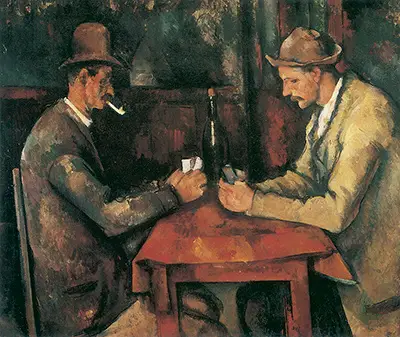 Buy Art Prints Now
Buy Art Prints Nowfrom Amazon
* As an Amazon Associate, and partner with Google Adsense and Ezoic, I earn from qualifying purchases.
The Card Players, by the post-Impressionist artist Paul Cezanne, are a series of five paintings depicting Provencal workmen studiously playing cards. They were painted in oil from the early to mid-1890s.
They vary in number of sitters and colours used and the later paintings are simplified concentrating on the essentials. Many consider this series to be among the most important works by Cezanne during this period enabling art to move forward to greater innovation.
Cezanne, born in Aix-en-Provence in 1839, was one of the most important painters of the French post-Impressionist movement rejecting the previously expected straightforward representation of people and nature and putting emphasis on geometric elements and interlocking forms that he saw reality as being constructed from.
He thought this vision would make his paintings 'solid and durable' and his work containing regular shapes of calculated volume put into practice his idea that painters should seek the cylinder, sphere and the cone and this paved the way towards Cubism.
The most reproduced of The Card Players series hangs in the Musee d'Orsay in Paris. It measures 47.5 x 57cm and is the smallest painting and the last painted. Many regard it as the finest of the series as it demonstrates more of Cezanne's unique technique.
The two male figures in this version are prismatic and angular but their gestures give them a dignified air. The geometric shapes that make up the picture emphasises the routine and ritual in card playing by the two men. The bottle at the centre divides the picture creating a sense of balance but not symmetry as the left-hand figure with the pipe is fully within the picture whereas the right-hand one is not.
The series as a whole may have been inspired by a painting depicting card players, painting by a Le Nain, that hung in a museum in Aix-en-Provence during Cezanne's youth. Cezanne, in his five paintings, created a variation on a motif found in several seventeenth century French and Dutch paintings that depicted games in rowdy settings. Cezanne replaced drunken gamblers with the dignified workmen on his estate and the tavern with more sober settings.
In 2011 the Royal Family of Qatar was reputed to have bought a version of The Card Players for between $250 million and $300 million. The enormous value reflects the level of influence this series has had on twentieth century artists as well as the pivotal role and enduring popularity of these paintings.




